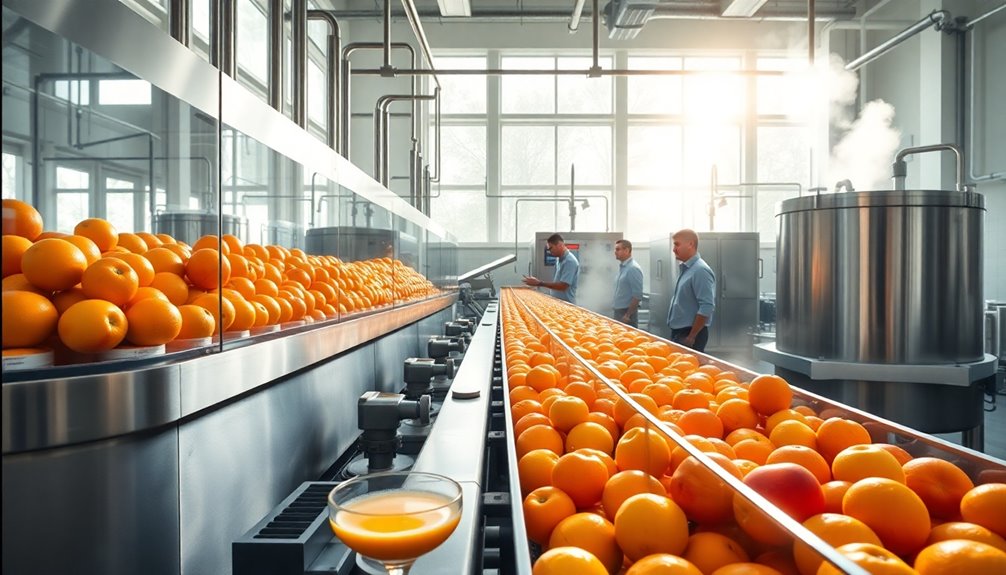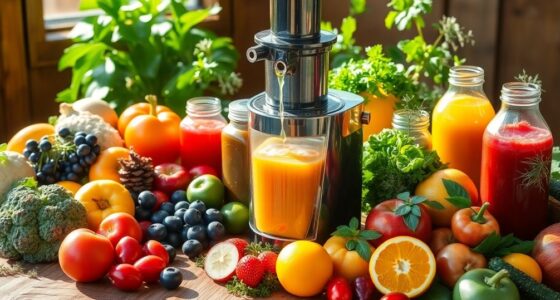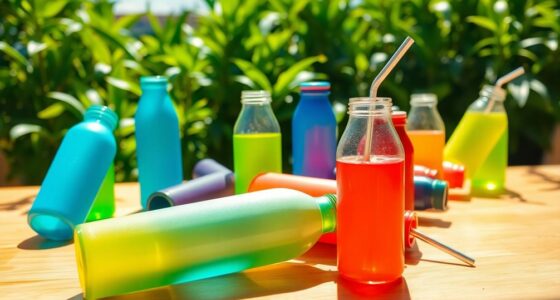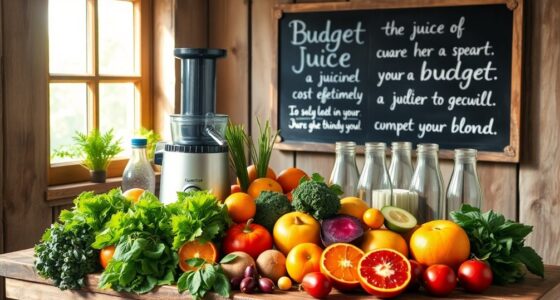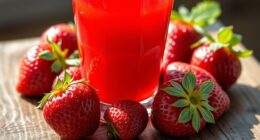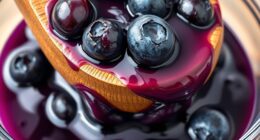In industrial juice manufacturing, you start with selecting high-quality raw materials like ripe oranges. Next, sorting and cleaning guarantee only the best fruit is processed. You'll prepare the fruit through efficient methods, then extract juice using techniques that maximize yield. Filtration and pasteurization follow to enhance safety and quality. Throughout, you'll embrace sustainability practices and harness technological advancements. As you explore further, you'll uncover even more critical steps and insights into this fascinating process.
Key Takeaways
- Selecting high-quality, ripe oranges with optimal juice content is crucial for producing premium juice.
- Advanced sorting and mechanical processing enhance fruit preparation efficiency and maintain hygiene standards.
- Juice extraction techniques like milling and diffusion maximize yield while preserving quality.
- Filtration and pasteurization processes ensure a smooth product and enhance safety without compromising flavor.
- Eco-friendly packaging and optimized distribution logistics support sustainability and maintain juice integrity during transport.
Selection of Raw Materials
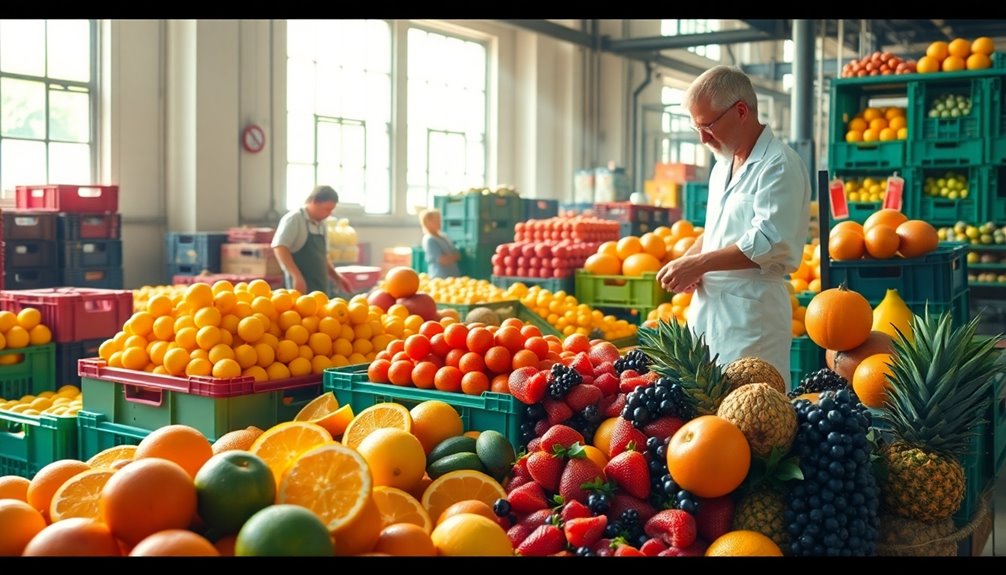
When selecting raw materials for industrial juice manufacturing, you'll want to prioritize high-quality fruits, like ripe oranges that are free from blemishes.
Ideal oranges should have at least 40% juice content and a sugar-to-acid ratio around 10:1 to enhance the taste of your orange juice.
Don't overlook the origin of the fruit; soil quality, climate, and farming practices greatly impact juice quality and yield.
Embracing sustainable practices, such as using organic fertilizers and integrated pest management, is essential for both environmental health and product quality.
Additionally, regular testing for pesticide residues and contaminants guarantees you meet food safety standards and consumer expectations.
Selecting the right raw materials sets the foundation for exceptional juice production.
Sorting and Cleaning
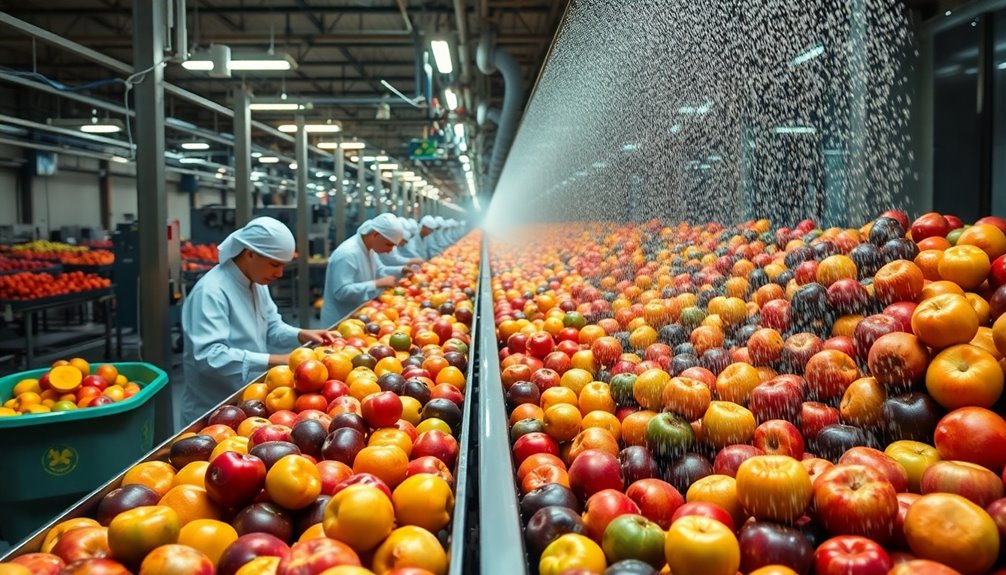
Sorting and cleaning are essential steps in industrial juice manufacturing that directly impact the quality of the final product.
Here's what makes these processes critical:
- Optimal Selection: Advanced sorting technology uses sensors and cameras to select the ripest oranges based on size and maturity, ensuring high juice quality.
- Waste Reduction: Effective sorting removes overripe or damaged oranges, minimizing waste and enhancing efficiency.
- Safety Assurance: The cleaning process follows sorting, washing the oranges to eliminate dirt, pesticides, and contaminants.
Preparation of Fruit

To guarantee the highest quality juice, fruit preparation starts with selecting ripe and healthy specimens. You'll want to ascertain only the best fruits are chosen, as they yield superior juice.
Utilizing advanced sorting machines equipped with sensors and cameras enhances your efficiency by accurately differentiating fruit sizes and maturity levels. After selection, mechanical processing technology washes the fruit, removing any contaminants and adhering to eco-friendly practices for hygiene.
In orange juice production, processing within 24 hours of harvesting is essential to maintain freshness. Following this, peeling and seed removal take place, with modern machinery designed to minimize waste. This approach not only maximizes juice extraction but also aligns with sustainability goals, guaranteeing a responsible manufacturing process.
Extraction Methods
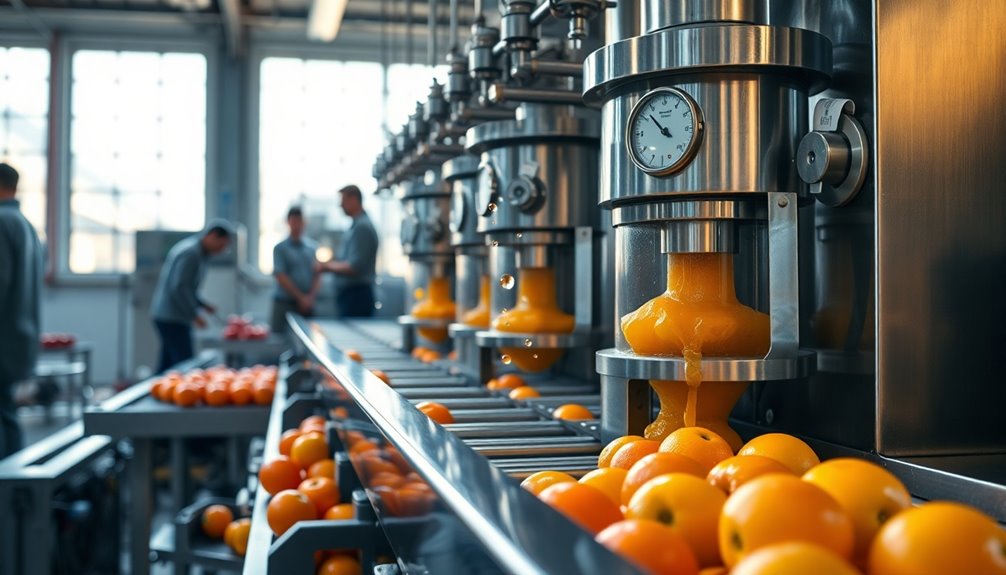
When it comes to juice extraction, you'll want to understand the key methods like milling, diffusion, and imbibition.
Each technique plays an essential role in maximizing juice yield and quality.
Let's explore how these processes work to get the most out of your fruits.
Milling Process Overview
The milling process is essential
Diffusion Techniques Explained
After maximizing juice extraction through milling, you can enhance the process even further with diffusion techniques.
These methods utilize the semi-permeable walls of parenchyma cells to equalize concentrations between the extraction fluid and shredded cane. Typically, horizontal bed diffusers are employed, allowing efficient percolation of water and diluted juice through a porous bed of shredded cane.
To achieve effective diffusion, it's essential to maintain a compact and permeable bed, aiming for a cell rupture index of around 94%.
Additionally, temperature plays a significant role; higher temperatures reduce microbial activity and affect the viscosity of the leaching liquid.
The resulting bagasse retains more moisture than traditional milling systems, influencing the subsequent steps in the beverage industry.
Imbibition Water Application
To enhance sucrose extraction during the milling process, you can apply imbibition water in three distinct methods: simple, compound, and mixed. Each method plays an essential role in optimizing your water application for maximum yield.
- Simple Imbibition: Water is added after each three-roll mill.
- Compound Imbibition: Water is applied at the last mill, with diluted juice returned to prior mills.
- Mixed Imbibition: Water is introduced at multiple mills, enhancing extraction by partially returning juice from intermediates.
For effective sucrose extraction, verify the liquid absorption reaches 250% of the fiber mass.
Additionally, keep the imbibition water temperature between 70°C to 80°C to maximize yield while preserving juice quality.
Filtration Processes
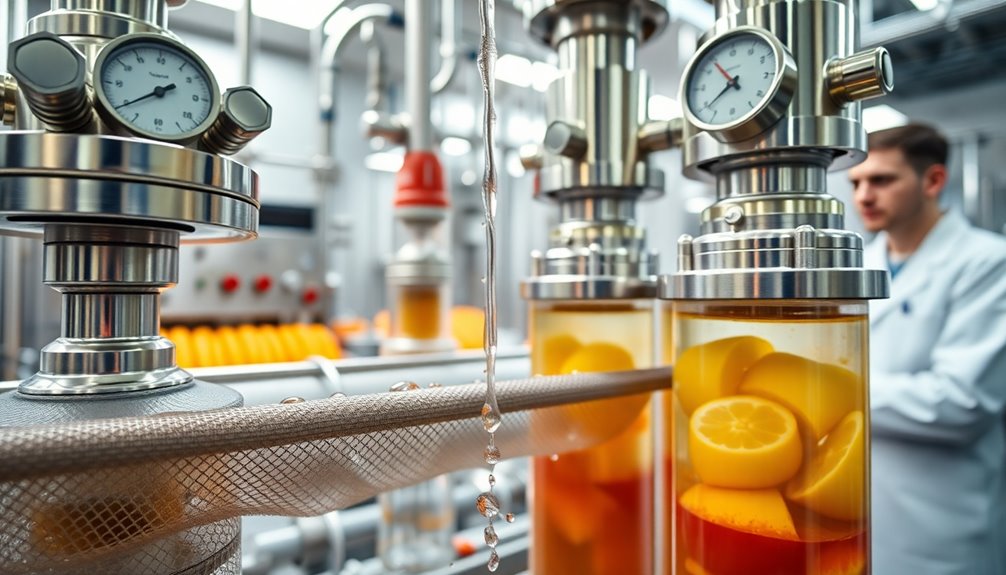
Filtration processes play an essential role in industrial juice manufacturing by effectively removing solids, pulp, and impurities, guaranteeing you get a smooth and clear final product. Companies producing food and beverage products rely on various methods like microfiltration and ultrafiltration to achieve the desired clarity while retaining vital nutrients. These processes can also enhance juice shelf life by reducing microbial load.
| Filtration Method | Key Benefits | Applications |
|---|---|---|
| Microfiltration | Removes larger particles | Clarity enhancement |
| Ultrafiltration | Retains nutrients, removes bacteria | Nutrient preservation |
| Cross-flow filtration | Continuous processing, efficiency | Large-scale production |
| Batch filtration | Simpler setup | Smaller operations |
| Membrane filtration | Versatile for various juices | Multi-product use |
Regular maintenance guarantees peak performance and juice quality.
Pasteurization Techniques
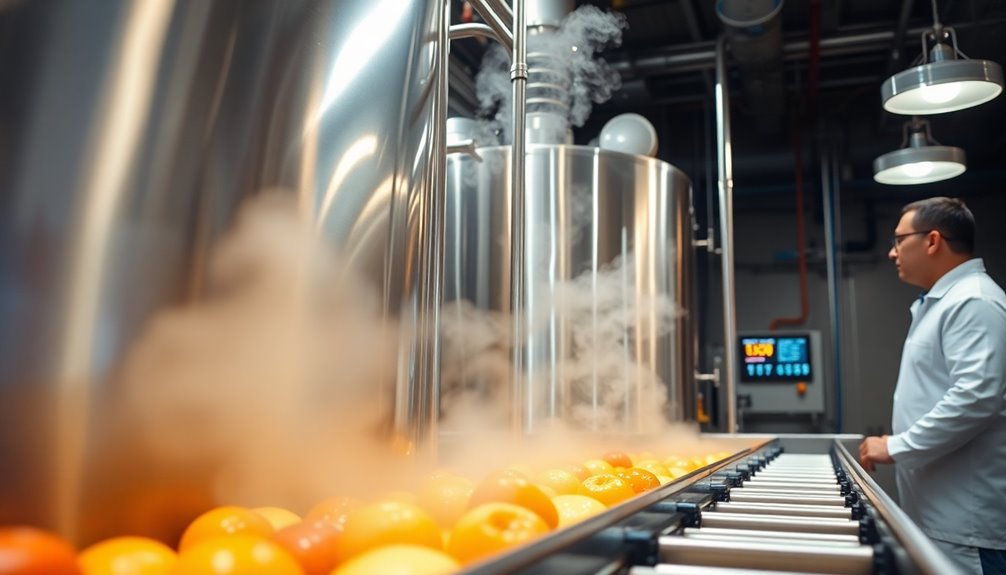
When it comes to pasteurization, you've got a couple of key methods to contemplate: batch and continuous.
Each technique offers distinct benefits, from enhancing safety to preserving the juice's flavor and nutrients.
Understanding these methods will help you appreciate their role in the juice manufacturing process.
Types of Pasteurization Methods
How can juice manufacturers guarantee both safety and quality in their products? By employing various pasteurization methods, they can effectively achieve this balance.
Here are three popular practices:
- High-Temperature Short-Time (HTST): Heats juice to at least 72°C for 15 seconds, killing harmful microorganisms while preserving flavor.
- Ultra-High Temperature (UHT): Exceeds 135°C for a few seconds, ensuring extended shelf life without refrigeration.
- Cold Pasteurization (HPP): Uses high pressure instead of heat to inactivate pathogens, maintaining fresh taste and nutrients.
These techniques are essential for ensuring the safety of fruit juices while retaining their quality.
Each method has its unique advantages, and choosing the right one depends on the type of juice and desired shelf life.
Benefits of Pasteurization Process
Pasteurization techniques offer considerable benefits that enhance both the safety and quality of juice products. By applying heat treatment, you effectively eliminate harmful microorganisms, greatly reducing the risk of spoilage and foodborne illnesses.
Typically, heating juice to temperatures between 70°C and 90°C guarantees a safer product while retaining essential nutrients and flavors. Different methods, like flash and batch pasteurization, provide unique advantages in energy efficiency and product quality.
Plus, pasteurized juice can enjoy a shelf life extension of several months without refrigeration, making distribution and storage much easier. Additionally, proper temperature monitoring during pasteurization ensures that the juice maintains its quality and safety throughout the production process.
Cooling and Storage
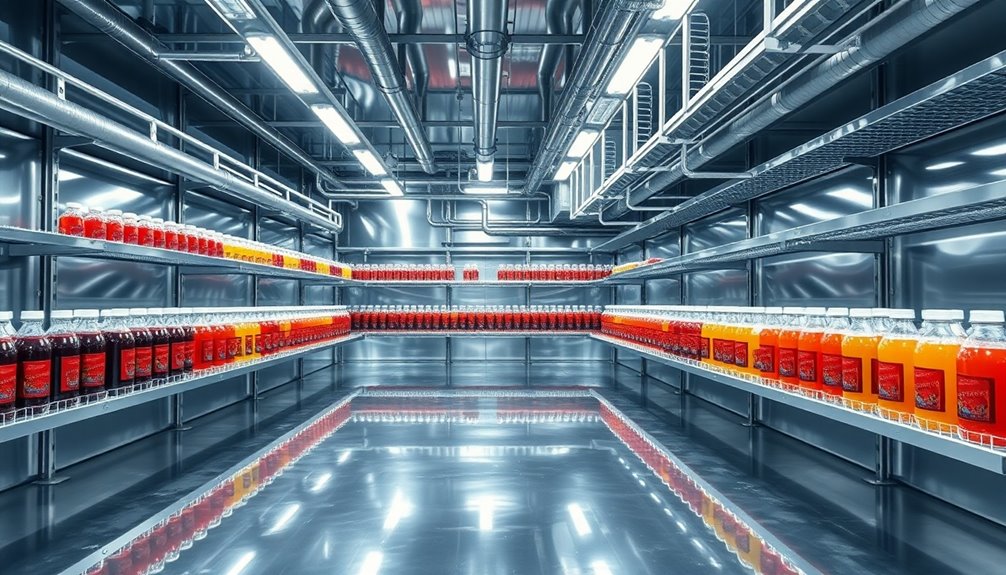
To preserve the freshness and safety of juice, it's essential to cool it rapidly after extraction. Cooling the juice to temperatures between 1°C and 4°C inhibits microbial growth and maintains its quality.
Here are key aspects of cooling and storage:
- Storage Tanks: Juice is stored in stainless steel tanks with temperature control systems to prevent spoilage.
- Capacity: Industrial facilities can hold thousands to millions of liters, depending on production scale and demand.
- Monitoring: Regular checks on temperature and oxygen levels guarantee the juice remains safe and high-quality.
Additionally, many facilities utilize a first-in, first-out (FIFO) inventory system to manage shelf life effectively, reducing waste and guaranteeing freshness for consumers. Furthermore, maintaining optimal storage conditions can help reduce spoilage rates, ensuring that the product retains its nutritional value and flavor.
Quality Control Measures
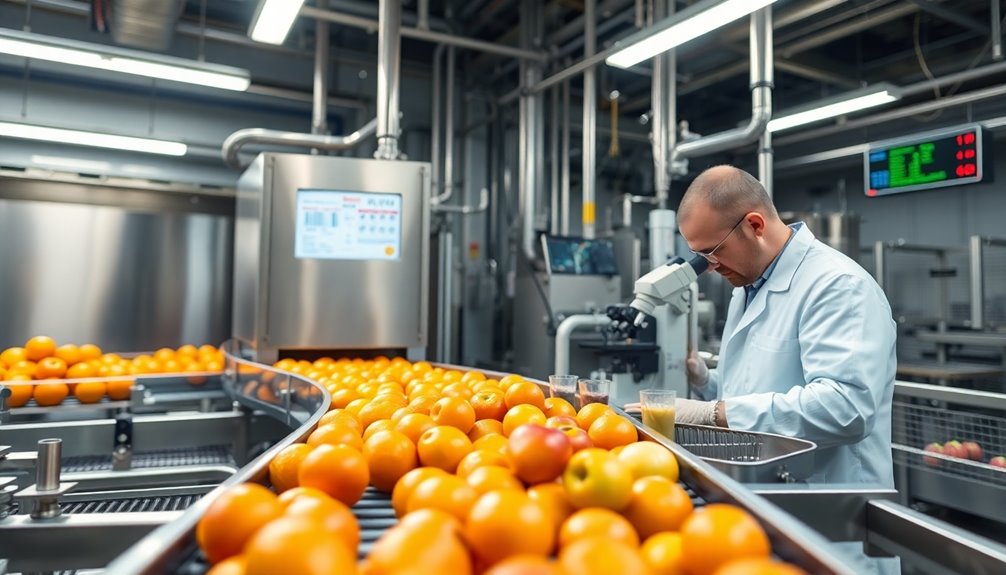
When it comes to quality control in juice manufacturing, you need to start with a thorough inspection of raw materials. This guarantees you're using only the best fruits, which directly affects the taste and nutrition of your final product. Additionally, ensuring that the fruits are rich in vitamins A, C, and K can significantly enhance the health benefits of the juice. Next, implementing process monitoring techniques will help you maintain ideal conditions throughout production.
Raw Material Inspection
Effective raw material inspection is essential in industrial juice manufacturing, guaranteeing only the highest quality fruits make it to the juicing process.
To achieve this, you should focus on:
- Assessing Quality: Check fruits for size, maturity, and any signs of damage or disease to guarantee peak juicing.
- Utilizing Technology: Employ mechanical processing with sensors and cameras during sorting for accurate identification of ripe oranges.
- Conducting Regular Tests: Monitor incoming fruit batches for sugar content, acidity, and pesticide residues to comply with food safety regulations.
Process Monitoring Techniques
Once you've secured the quality of your raw materials, maintaining that standard throughout the manufacturing process becomes crucial.
Regular monitoring of juice clarity, color, and flavor guarantees consistency and adherence to industry standards. Utilize sensors and automated systems for real-time tracking of critical parameters like temperature and pH during processing, which keeps ideal conditions intact.
Don't overlook microbial testing; it's essential for preventing contamination and guaranteeing food safety, with strict pathogen limits in place.
Additionally, analyze your incoming fruit for ripeness and defects to produce high-quality juice.
Implement traceability systems to track your product from harvest through processing to packaging, allowing quick responses to any quality issues and boosting consumer confidence in your brand. Including natural supplements like turmeric in your production process can enhance the health benefits of your juice.
Packaging Innovations
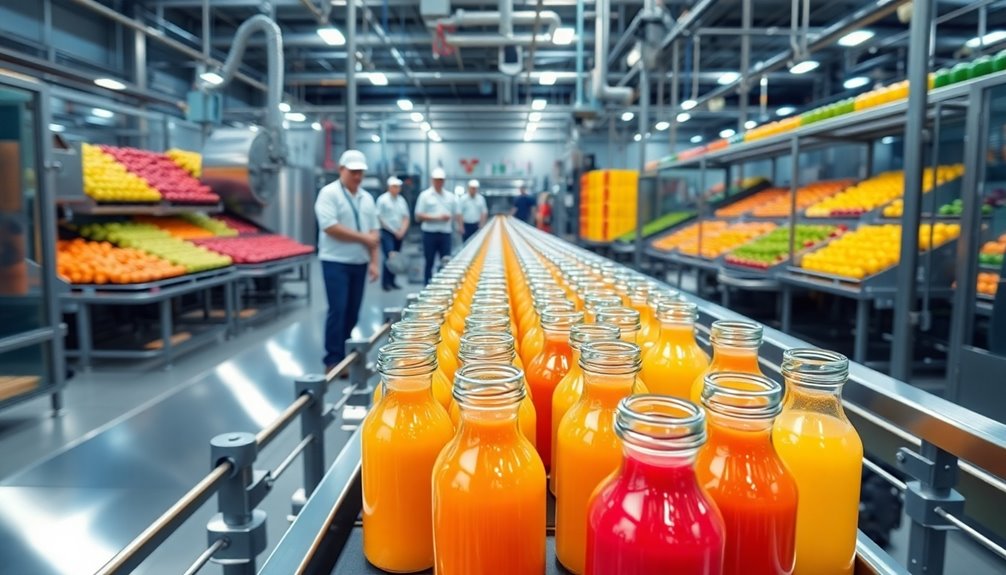
As consumers increasingly seek sustainable options, the juice industry is embracing innovative packaging solutions that meet these demands.
You'll find that these advancements not only enhance the product but also reduce environmental impact. Here are some key innovations:
- Eco-friendly materials: Lightweight and recyclable options are becoming standard, considerably lowering carbon footprints.
- Smart packaging: QR codes and NFC tags allow you to access freshness tracking and product info seamlessly.
- Advanced preservation: Techniques like vacuum sealing and modified atmosphere packaging (MAP) extend shelf life by minimizing oxidation and contamination.
These innovations align with consumer preferences for sustainability while improving efficiency through automated systems, ensuring quality and reducing costs in juice packaging.
Distribution Logistics
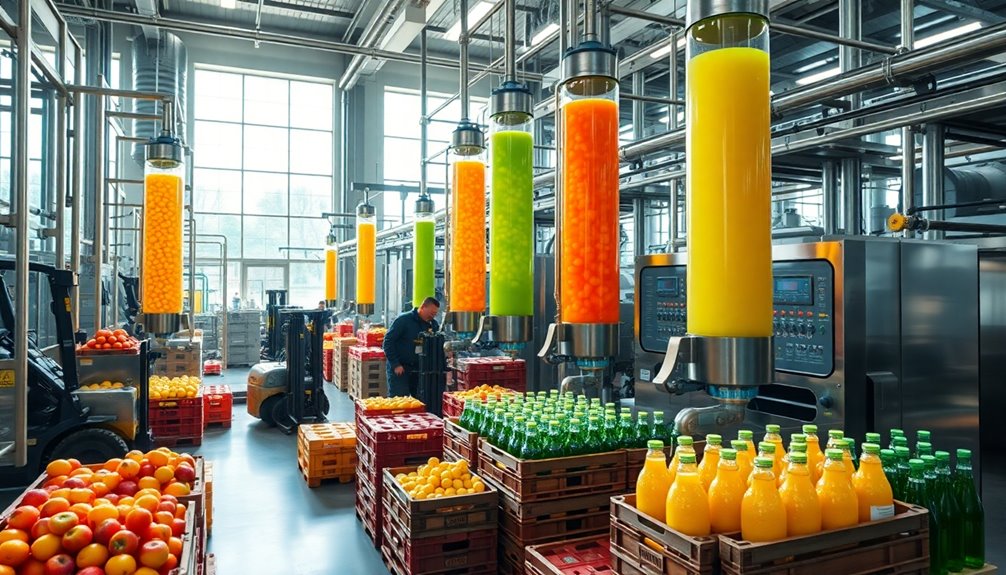
When you think about distribution logistics in juice manufacturing, transport efficiency strategies play a key role in keeping your products fresh.
You need to optimize your supply chain to guarantee timely deliveries and minimize losses.
Transport Efficiency Strategies
Effective transport efficiency strategies are essential for juice manufacturers looking to enhance their distribution logistics. By focusing on optimizing routes, you can reduce fuel consumption and delivery times.
Here are three key strategies to take into account:
- Implement Advanced Tracking Systems: This enhances visibility, enabling quick responses to demand fluctuations and minimizing stockouts.
- Collaborate with Third-Party Logistics Providers: Leverage their expertise for efficient transportation and warehousing solutions.
- Utilize Temperature-Controlled Transport: This preserves juice quality and flavor during distribution, preventing spoilage.
Regularly analyzing logistics performance metrics, like delivery times and costs, will provide insights for continuous improvement.
Supply Chain Optimization
To thrive in the competitive juice manufacturing industry, optimizing your supply chain is essential for maintaining efficient distribution logistics.
Start by leveraging advanced technology and data analytics to enhance stock management and track inventory in real-time. This approach minimizes disruptions, especially in crisis situations like the COVID-19 pandemic.
Streamlined logistics strategies can reduce transportation costs and improve delivery times, boosting customer satisfaction.
Additionally, developing online marketing strategies and exploring new export markets can diversify your distribution channels, mitigating logistics risks.
Finally, prioritize flexible supply chain practices that adapt to unforeseen challenges, ensuring consistent product availability.
Sustainability Practices
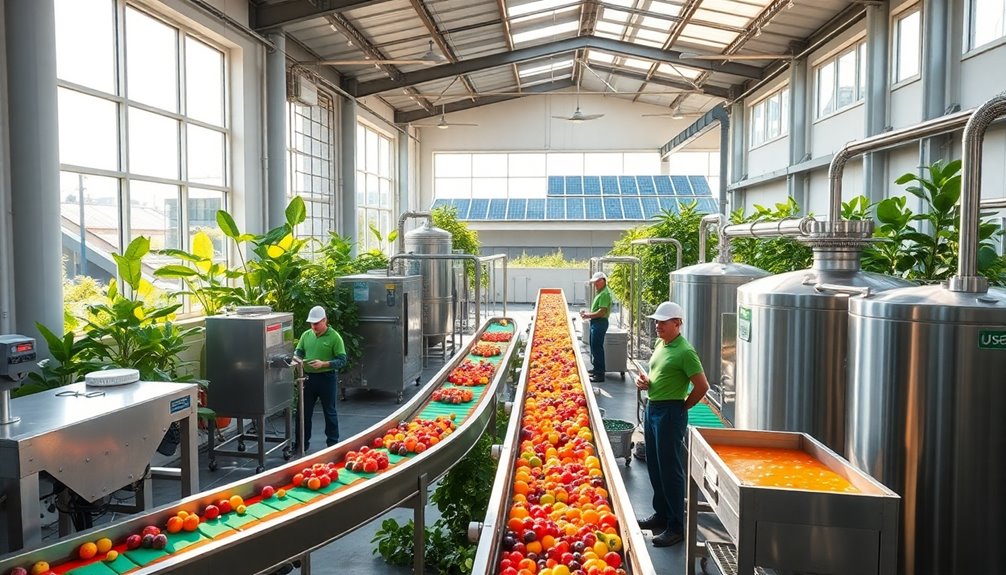
Sustainable practices in orange farming not only benefit the environment but also enhance the quality of the fruit you enjoy.
By incorporating these methods, farmers can provide you with healthier, tastier oranges:
- Drip Irrigation: This technique conserves up to 50% more water compared to traditional methods.
- Natural Pest Control: Utilizing natural predators greatly reduces the need for chemical pesticides, promoting a healthier ecosystem.
- Eco-friendly Fertilizers: Using cover crops and organic fertilizers improves soil health, increases biodiversity, and results in higher quality fruit.
These sustainable approaches have been shown to elevate antioxidant levels in organically grown oranges, making them a better choice for both your health and the planet.
Embracing these practices is a win-win for everyone involved!
Waste Management Strategies
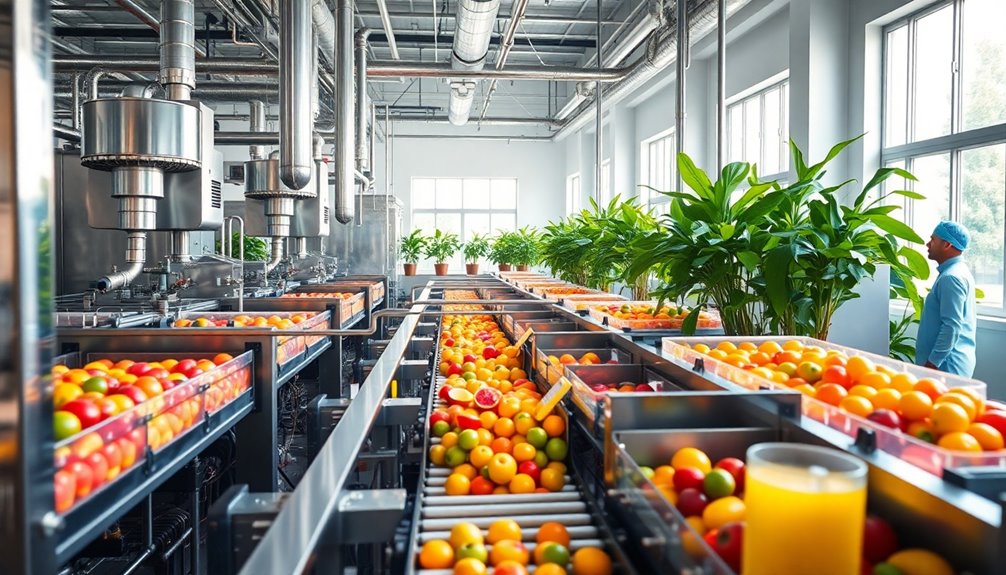
As juice manufacturers endeavor to minimize their environmental impact, implementing robust waste management strategies becomes essential.
Start by recycling by-products like bagasse and seeds, which can be repurposed for bioenergy or animal feed, cutting waste volume by up to 50%.
Adopting a zero-waste policy can save costs, allowing you to recover valuable materials and potentially generate additional revenue of 5-10%.
Utilize anaerobic digestion for organic waste, producing biogas for energy needs and reducing fossil fuel reliance.
Verify you have effective wastewater treatment systems that can remove up to 90% of contaminants.
Finally, conduct regular audits to identify inefficiencies, leading to a 20-30% reduction in waste generation over time.
Implementing these strategies is key to sustainable juice manufacturing.
Technological Advancements
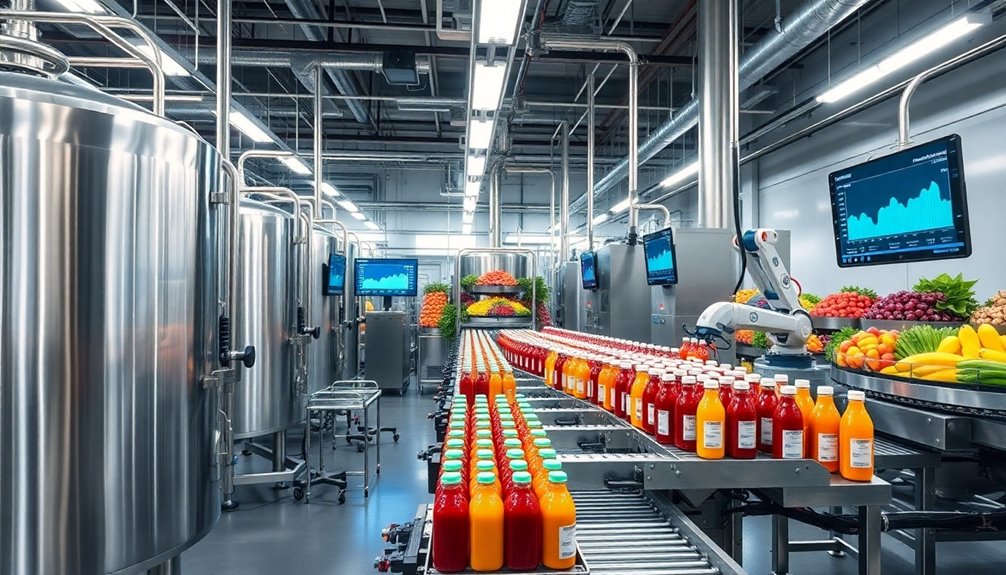
While many juice manufacturers focus on traditional methods, embracing technological advancements can greatly enhance efficiency and product quality.
By integrating these innovations, you can achieve remarkable improvements in your production process. Consider these key benefits:
- Advanced Sorting Technologies: Sensors and cameras help you selectively harvest the ripest oranges, ensuring exceptional juice quality.
- Modern Juicing Machines: Designed for rapid extraction, they minimize waste and maximize yield from every fruit.
- Automation and AI: Streamlining operations and optimizing resource use, these systems reduce environmental impact and improve overall efficiency.
Incorporating these advancements not only boosts your output but also supports sustainable practices, promoting an eco-friendly approach in the juice industry. Additionally, utilizing air quality monitoring can further enhance the production environment, ensuring a cleaner workspace for workers.
Embrace technology to stay competitive and meet evolving market demands.
Market Trends and Consumer Preferences
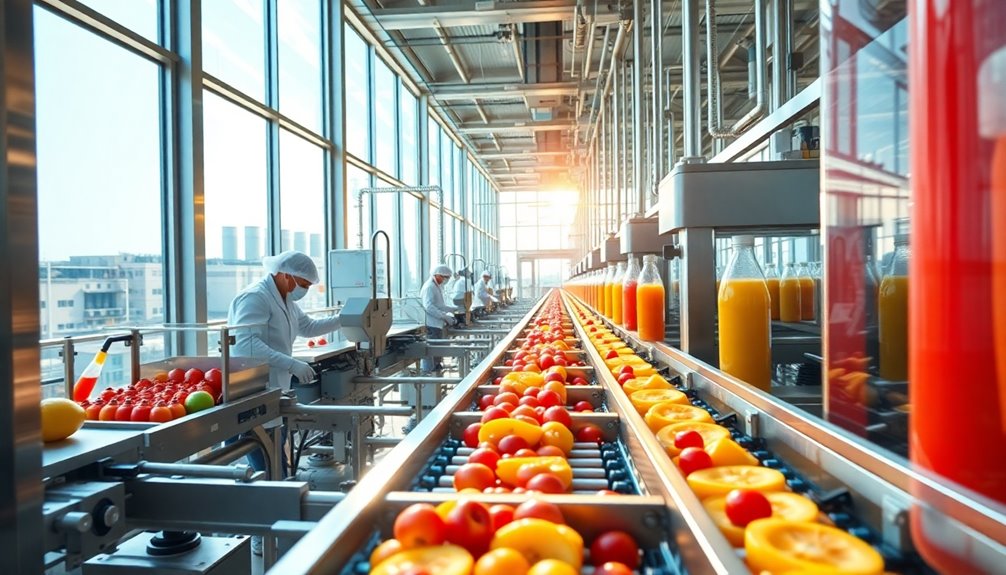
How have market trends shifted in the juice industry? The COVID-19 pandemic revealed vulnerabilities in logistics, prompting a demand for healthier, natural options. You'll notice consumers now prefer organic and less processed juices, pushing companies to adapt their offerings. Sustainability's become essential, too; eco-friendly practices are no longer optional but expected. Additionally, as online shopping surged, juice producers are leveraging digital marketing to connect directly with consumers. Juice cleansing, known for its health benefits, has also gained popularity as individuals seek detoxification and weight loss solutions.
| Trend | Consumer Response |
|---|---|
| Shift to Healthier Options | Increased demand for organic |
| E-commerce Growth | Direct purchases via online |
| Eco-friendly Practices | Preference for sustainable produce |
| Vulnerability Awareness | Focus on resilient supply chains |
| Emerging Markets | Exploration of new revenue streams |
These trends highlight a changing landscape that you must navigate.
Frequently Asked Questions
What Is the Manufacturing Process of Juice Industry?
In the juice industry, you start by carefully harvesting ripe fruits, ensuring quality.
Next, you sort them using advanced technology to choose the best ones for juicing.
After extraction, the juice goes through filtering to remove seeds and pulp, resulting in a smooth product.
Throughout this process, sustainable practices, like drip irrigation, are essential.
Innovations like AI-driven sorting and automated harvesting boost efficiency, making the entire operation more effective and environmentally friendly.
What Are the Steps in Preparing Juice?
To prepare juice, you start by selecting and sorting the ripest fruits.
After that, you wash them thoroughly to remove dirt and contaminants.
Next, you use hydraulic or mechanical presses to extract the juice, ensuring minimal waste.
Once extracted, you filter the juice to eliminate seeds and pulp, creating a smooth product.
Finally, you pasteurize the juice for safety, then bottle it up for distribution, keeping it fresh and ready to enjoy.
What Is the Correct Order of Juice Processing?
Imagine you're crafting a perfect smoothie; each step's essential.
In juice processing, you start by sorting the fruit, ensuring only the ripest oranges make the cut. Next, you wash them, then press to extract juice.
After that, you filter it for smoothness and pasteurize to kill harmful germs. Finally, you package the juice to lock in freshness.
Following this order guarantees a high-quality product that you'll enjoy sipping on!
What Is the Process of Extracting Sugarcane Juice?
To extract sugarcane juice, you start by milling the cane stalks between rotating rollers, crushing them to release the juice.
You might enhance this process by adding water during imbibition, which can be simple, compound, or mixed.
After milling, you'll find that bagasse retains moisture, affecting your next steps.
Keep the temperature between 70°C and 80°C to optimize extraction, and consider diffusion as an alternative method for better efficiency.
Conclusion
To sum up, diving into industrial juice manufacturing is like peeling an onion—you uncover layers of complexity and insight at every turn. By understanding the detailed steps from raw material selection to sustainable practices, you’re better equipped to navigate this vibrant industry. Embracing these processes not only enhances product quality but also aligns with evolving market trends and consumer preferences. So, whether you’re a producer or a curious consumer, knowing these steps can help you appreciate the juice in your glass even more. Moreover, investing in the latest technology, such as engineered machinery for juice production, can significantly streamline operations and improve efficiency. This machinery not only enhances the extraction process but also ensures that vital nutrients are preserved, resulting in a higher-quality product. By staying informed about advancements in equipment and techniques, industry players can maintain a competitive edge while satisfying the demands of health-conscious consumers.
Cindy thoroughly researches juicing trends, techniques, and recipes to provide readers with practical advice and inspiration. Her writing style is accessible, engaging, and designed to make complex concepts easy to understand. Cindy’s dedication to promoting the advantages of juicing shines through her work, empowering readers to make positive changes in their lives through the simple act of juicing.

